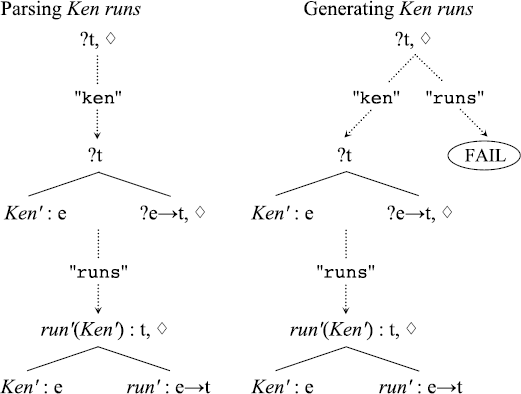1 Introduction
In spontaneous discourse, a speaker occasionally encounters a word-formulation problem and uses several linguistic strategies. One of such strategies is the use of “placeholders” (PHs).
- (1)
- [Naomi needs a pair of scissors to open a box. She is trying to ask Ken, her flatmate, to find it for her, but the expression a pair of scissors temporarily eludes her.]
- I need a whatchamacallit…, a pair of scissors.
- (2)
- [Noami and Ken found dogs’ dung in front of their house, and she screams.]
- This you-know-what is really disgusting!
In general, a speaker employs a PH when she is unable or unwilling to produce a target form. (The definition of PHs will be presented and discussed in detail in Section 2.) In (1), Naomi is unable to utter a pair of scissors due to memory lapse and resorts to the PH whatchamacallit. In (2), Naomi is able but unwilling to utter dung, a culturally sensitive term, and she opts to use the PH you-know-what in lieu of the target form.
There is a growing body of work on PHs, but most previous studies are descriptive and/or functional (Channell 1994; Kitano 1999; Hayashi 2003; Hayashi & Yoon 2006; Amiridze et al. 2010; Palacios Martínez & Núñez Pertejo 2015; see Seraku 2022a for further references). That is, as will be mentioned in Section 2, whilst some studies provide theoretical analyses (Enfield 2003; Jucker et al. 2003; Hengeveld & Keizer 2011; Tárnyiková 2019; Seraku 2020, 2022a), little attempt has been made to develop formal analyses (Sudo 2008; 2013; Cheung 2015; Sailer & Dörne 2021). In the present article, we aim to fill this gap by articulating formal grammars for PHs and modelling the syntactic and dialogic properties of PHs in a variety of languages. We said formal grammars (with plural -s) because our proposal is concerned with the general mechanism of how a PH is processed online and the ways in which this general mechanism is implemented in natural language grammars.
We will begin by setting out an empirical basis. Section 2 clarifies the notion of PHs in detail, and Section 3 describes PHs in Japanese, French, and German, presenting new data on gender mismatches. In Sections 4–5, we propose a formal account within Dynamic Syntax (Kempson et al. 2001; 2016; Cann et al. 2005), a grammatical architecture that gradually builds up conceptual structures based on dynamic (i.e. time-linear) parsing. A bonus of this dynamic approach is its broad empirical coverage; as will be argued in Section 6, it handles not only grammatical but also dialogic properties of PHs. By way of conclusion, Section 7 draws empirical and theoretical implications from the present enquiry.
2 Empirical background
Seraku (2022a) defines PHs as in (3).
- (3)
- A PH is a linguistic item with which a speaker/writer fills in the slot of a target form that she is unable or unwilling to produce for some contextual reasons.
This basic definition is more or less presupposed in most previous studies (e.g. Channell 1994; Jucker et al. 2003; Hengeveld & Keizer 2011; Cheung 2015; Palacios Martínez & Núñez Pertejo 2015; Seraku 2020), though PHs have been labelled differently, as in “vague word” (Kaye 1990), “nonsense word” (Crystal 1995), and “dummy” (Hengeveld & Keizer 2011). Another disparity in the definitions of PHs concerns the specifications of “reasons” why a speaker/writer is unable or unwilling to produce a target form; this point will be elaborated on shortly (see the paragraph around example (8)).
Definition (3) consists of three essential parts, as marked in bold. We illustrate them with English and Japanese examples. First, a PH fills in a certain slot of a sentence structure. In (1), whatchamacallit occupies an object slot. In (4) below, the Japanese PH are, which derived from the distal demonstrative are ‘that’,1 occupies a subject slot.
- (4)
- [The speaker, who is delivering a linguistics presentation, answers a question from the floor, saying that the example offered by the questioner is irrelevant to his main point.]
- Kore
- this
- shugo-desu-yone.
- subject-cop-fp
- Desukara
- so
- maa
- intj
- ano
- intj
- bunpootekina
- grammatical
- ano
- intj
- are-ga
- ph-nom
- kinoo-ga
- function-nom
- chotto
- somewhat
- chigau-ndesu-keredomo
- differ-mm-but
- […]
- ‘This (i.e. the phrase you mentioned) is a subject, isn’t it. So, the grammatical ph (= function) is different, but…’ [Japanese (CSJ)]2
The “filling-in” nature of PHs distinguishes them from interjective fillers such as um in I live in, um, Tokyo, where um occupies neither a nominal nor a predicative slot. This property of PHs is important because the motives for using PHs (e.g. memory lapse, politeness) are often similar to the motives for using interjective fillers (Clark & Fox Tree 2002: 90–91).
Second, a PH substitutes for a target form. In the examples presented above, the category of a target form is a noun, but the following examples show that a target form may be a verb (5) or an adjective (6). In (5), areshi- is the infinitive form of the verbal PH aresuru, which derived from the composition of the nominal PH are (see (4)) and the light verb -suru ‘do’.
- (5)
- [The speaker regrets not going out much when he lived in Tokyo.]
- Moosukoshi
- a.little.more
- nantoka
- somehow
- anoo
- intj
- areshi-te
- ph-cvb
- moosukoshi
- a.little.more
- asobiarui-te
- jaunt.around-cvb
- anoo
- intj
- chishiki-o
- knowledge-acc
- e-tai-to
- gain-des-quot
- omot-te
- think-cvb
- […]
- ‘It would have been better if I ph-ed (= had jaunted around) a bit more and had gained knowledge…’ [Japanese (CSJ)]
In (6), the adjectival PH aredesu, which derived from the composition of the nominal PH are and the copula -desu, substitutes for damedesu ‘unavoidable’.
- (6)
- [The speaker and his wife used to be flatmates. He initially did not intend to marry her, but whilst they lived together, her parents came and asked him to marry her.]
- Sono
- that
- dookyonin-no
- roommate-gen
- oya-ga
- parent-nom
- nanka
- intj
- niigata-ken-kara
- Niigata-prefecture-from
- ki-te
- come-cvb
- [uchi-no
- [1pl-gen
- musume-o
- daughter-acc
- onegaishimasu]-mitaina.
- please]-like
- Sooiu
- such
- tsumori-janakat-ta-noni
- intention-cop.neg-pst-but
- mitai
- like
- demo
- but
- moo
- now
- aredesu
- ph
- damedesu-ne.
- unavoidable-fp
- ‘The parents of that flatmate came from Niigata prefecture and said to me something like “Please take good care of our daughter.” I didn’t intend to marry her, but it’s ph (= unavoidable).’ [Japanese (CSJ)]
As pointed out in Seraku (2022b), it does not seem that a PH always substitutes for a linguistic expression. In (7), it is possible that Naomi only has in mind a vague concept such as ‘a tool for opening a box’ and utters whatchamacallit to save her the effort to search for a specific expression (e.g. a pair of scissors).
- (7)
- [Naomi has difficulty opening a box, and she talks to Ken, her flatmate.]
- I need a whatchamacallit.
In Section 5, we will develop an account that captures examples such as (7) where a speaker may not think of any concrete target form.
Finally, a speaker uses a PH when she is unable or unwilling to produce a target form (or in case there is no concrete target form, to verbalise her concept). An “unable”-motive is illustrated in (1), where the speaker runs into problems with producing the target form due to memory lapse. In other situations, a speaker who is reading a passage aloud may find illegible words (Cheung 2015: 276), or a target form may be unavailable in a language due to a lexical gap (Hengeveld & Keizer 2011: 1965). An “unwilling”-motive is illustrated in (2), where the speaker uses the PH because the target form is a culturally sensitive term. In other situations, a speaker tries to prevent third parties from overhearing a target form (Seraku 2020: 5), or a speaker intends to create a collusive air among the conversation participants, as in (8).
- (8)
- [John and Mary organised a party. After the main dishes, he is about to serve peaches as unexpected dessert. Before serving them, he says the following to her with an intent to pleasantly surprise the guests.]
- I think it’s time to serve the you-know-whats. (Enfield 2003: 106)
There are further types of ability-related and preference-related motives; see, e.g., Channell (1994), Amiridze et al. (2010), and Palacios Martínez & Núñez Pertejo (2015).
3 Empirical findings
In this section, we are going to describe more specific properties of PHs in Japanese, French, and German (Sections 3.1–3.3) and discuss their implications for previous studies (Section 3.4).
3.1. Japanese
Japanese PHs have been extensively examined (Uemura 1996; Kitano 1999; Hamaguchi 2001; Hosoda 2002; Hayashi 2003; Hayashi & Yoon 2006; Suga 2018; Seraku 2022a; 2022b), but what has received little attention is that a target form may be a syntactically negated predicate. Consider (9) (see Seraku et al. 2021: 83–84 for further data).
- (9)
- [Two females are talking about a famous male TV personality in Japan.]
- Anmari
- much.npi
- shaberu-no-ga
- talk-nmls-nom
- aredesu-yone.
- ph-fp
- Kooiu
- this.kind
- baraetii-de
- variety.programme-in
- shaberi-soona
- talk-seem
- kanji-ja-nai-desu-yone.
- feeling-cop-neg-hon-fp
- ‘He (= the famous TV personality) is much ph (= e.g. not good at) talking, isn’t he. He doesn’t look like a person who talks a lot in this kind of variety programme, does he?’ [Japanese (CSJ)]
The NPI anmari occurs without a negator.3 The acceptability of (9) suggests that the adjectival PH aredesu substitutes for a negated form such as tokuija-nai-desu ‘good.at-neg-hon’ (= ‘not good at’). If aredesu is replaced with the non-negated predicate tokuidesu ‘good at’, the NPI is no longer licensed, as can be seen in (10).
- (10)
- *Anmari
- much.npi
- shaberu-no-ga
- talk-nmls-nom
- tokuidesu-yone.
- good.at-fp
- Int. ‘He is very good at talking, isn’t he.’ [Japanese]
Unlike the adjectival PH aredesu, the verbal PH aresuru cannot license NPIs without a negator. This is shown in (11), where areshi- is the infinitive form of aresuru.
- (11)
- *Kinoo-wa
- yesterday-top
- anmari
- much.npi
- areshi-ta-yo…,
- ph-pst-fp
- etto…,
- well
- ne-nakat-ta-yo.
- sleep-neg-pst-fp
- Int. ‘I ph-ed much yesterday…, well…, didn’t sleep much.’ [Japanese]
Example (11) is grammatical if areshi-ta-yo ‘ph-pst-fp’ is replaced with its negated analogue: areshi-nakat-ta-yo ‘ph-neg-pst-fp’.
As mentioned in Section 2, previous studies generally assume that a PH is meta-linguistic in that it substitutes for a linguistic expression. This assumption is corroborated by (9); in this example, what the PH substitutes for is a negated form such as ‘not good at’, where the negator grammatically licenses the NPI anmari.
3.2. French
Let us turn to French PHs. The focus of our description lies in what we may call a “gender mismatch”. We say a gender mismatch occurs when a PH-involving sentence S is grammatical but the replacement of the PH with its target form causes inconsistency in gender agreement and renders S ungrammatical. We will illustrate this with French truc and machin.
French PHs are briefly noted in a few studies (Palacios Martínez & Núñez Pertejo 2015: 428, Vogel 2020), but they offer no concrete data. We thus start with basic examples.
- (12)
- [Emma wants to use a washing machine and needs a detergent. She asks Leo about its whereabouts, but she cannot remember the word détergent ‘detergent’.]
- J’ai
- I.have
- besoin
- necessity
- du
- of.the.mas
- truc/machin
- ph
- pour
- for
- laver
- wash
- le
- the
- linge.
- laundry
- ‘I need a ph (= detergent) to wash the laundry.’ [French]
Emma fails to utter the target word détergent ‘detergent’ on the spot and fills in its slot with truc or machin. When a speaker refers to tangible objects, as in (12), truc and machin are both permitted. These PHs may also be deployed to refer to intangible objects, as in (13).
- (13)
- [Emma thinks that the Tokyo Olympics may be cancelled due to COVID-19. Leo said that he had been looking forward to the Olympic Games, and she says the following, without mentioning COVID-19 because of its socially sensitive nature.]
- Les
- the
- jeux
- games
- Olympiques
- Olympics
- pourraient
- might
- être
- be
- annulés
- cancelled
- en
- in
- raison
- reason
- du
- of.the.mas
- truc/machin.
- ph
- ‘The Olympic Games might be cancelled due to the ph (= COVID-19).’ [French]
When a speaker refers to persons, machin is preferred to truc and used without an article.
- (14)
- [Emma is walking with Leo. She sees Adam, their mutual friend, reading a newspaper on a bench. Emma dislikes Adam, and she does not want to mention his name.]
- Tiens,
- hey
- il
- it
- y
- there
- a
- have
- machin
- ph
- qui
- who
- lit
- read
- un
- a
- journal
- newspaper
- là-bas.
- over.there
- ‘Hey, there is ph (= Adam) who is reading a newspaper over there.’ [French]
In (12)–(13), the use of du, a contraction of de ‘of’ and the masculine le ‘the’, indicates that the gender of truc and machin is masculine. This is consistent with the gender of their target words: détergent in (12) and COVID-19 in (13).4 In (15), a gender mismatch occurs.
- (15)
- [Emma is fixing a clock with a screw, but the screw is too small. So, she wants Leo to give her a bigger one, but she cannot remember the form vis ‘screw’ and its gender.]
- J’ai
- I.have
- besoin
- necessity
- d’un
- of.a.mas
- plus
- more
- gros
- big.mas
- truc/machin
- ph
- (ah
- (ah
- oui…,
- yes
- vis).
- screw.fem)
- ‘I need a bigger ph (…, ah yes…, screw).’ [French]
The target form here is vis ‘screw’. This is particularly evident when Emma suddenly recalls the word vis and utters it later, as shown in parentheses. The gender of vis is feminine, and it is incompatible with the gender of truc/machin. Thus, the replacement of truc/machin with vis results in ungrammaticality, as can be seen in (16)a, which sharply contrasts with (16)b.
- (16)
- a.
- *J’ai
- I.have
- besoin
- necessity
- d’un
- of.a.mas
- plus
- more
- gros
- big.mas
- vis.
- screw.fem
- Int. ‘I need a bigger screw.’ [French]
- b.
- J’ai
- I.have
- besoin
- necessity
- d’une
- of.a.fem
- plus
- more
- grosse
- big.fem
- vis.
- screw.fem
Emma could produce (15) appropriately even when she does not recall the target form itself but remembers its gender (i.e. feminine) at the time of uttering masculine d’un and gros.
This subsection has described the French nominal PHs turc and machin with special reference to the gender-mismatch phenomena. As will be pointed out in the next subsection, another type of gender mismatch is observed in German.
3.3. German
German PHs have been surveyed from a morphological point of view (Vogel 2020) and from the perspective of language education (Cutting 2015; 2019), but their grammatical properties have been largely untouched. An exception is Sailer & Dörne (2021), who describe and model morphosyntactic issues in German PHs; still, they do not discuss gender-mismatch phenomena. In what follows, we consider the nominal PHs Dings, Dingens, Dingsda, and Dingsbums, all of which derived from Ding ‘thing’ (Vogel 2020: 373). For the sake of presentation, Dingens is chosen as a representative form in the examples to be presented below.
In German, when a noun combines with an article and adjectives, they agree in terms of case, number, and gender (i.e. masculine, feminine, neuter). In the case of Dingens, however, its form remains the same irrespective of the case, number, and gender of its target form. In (17), Dingens substitutes for Schraube ‘screw’, a feminine noun.
- (17)
- [Hanna is fixing a clock with a screw, but the screw is too small. So, she wants Ben to give her a big screw. She knows that the word for a screw is feminine, but she cannot remember the form Schraube ‘screw’.]
- Ich
- I
- brauche
- need
- eine
- a.fem
- große
- big.fem
- Dingens.
- ph
- ‘I need a big ph (= screw).’ [German]
From the hearer’s point of view, the feminine forms eine ‘a’ and große ‘big’ perform a filtering function: the hearer, who hears the speaker uttering these feminine forms, only searches the context for entities that can be denoted by feminine nouns.
In the context of (17), the speaker cannot use the masculine forms for ‘a’ and ‘big’ since she is aware at the time of speech that the target form is feminine.
- (18)
- [The same context as (17)]
- ♯Ich
- I
- brauche
- need
- einen
- a.mas
- großen
- big.mas
- Dingens.
- ph
Note that (18) itself is grammatical and may be uttered appropriately in different contexts, e.g., when the speaker is referring to an entity denoted by a masculine noun such as Schraubendreher ‘screwdriver’. This is why (18) is marked with ♯, rather than *.
Then, what form would a speaker use for an article and adjectives when she cannot recall the gender of a target form? In such cases, a neuter form may be used, as shown in (19).
- (19)
- [Hanna is fixing a clock with a screw, but the screw is too small. So, she wants Ben to give her a big screw, but she cannot recall the word for a screw and its gender.]
- Ich
- I
- brauche
- need
- ein
- a.neut
- großes
- big.neut
- Dingens
- ph
- (…,
- (
- ähm…,
- well
- Schraube).
- screw.fem)
- ‘I need a big ph (…, well…, screw).’ [German]
Unlike (17), the speaker in (19) cannot select the feminine forms because she cannot recall the gender of a target form. As shown in parentheses in (19), the use of the neuter forms ein and großes is appropriate even if the non-neuter target form Schraube is uttered subsequently. This is where a gender mismatch occurs. If Dingens in (19) is replaced with its target form Schraube, the sentence becomes ungrammatical, as shown in (20)a, which is in stark contrast with (20)b.
- (20)
- a.
- *Ich
- I
- brauche
- need
- ein
- a.neut
- großes
- big.neut
- Schraube.
- screw.fem
- Int. ‘I need a big screw.’ [German]
- b.
- Ich
- I
- brauche
- need
- eine
- a.fem
- große
- big.fem
- Schraube.
- screw.fem
The mismatch data in German differ from those in French. In French, truc and machin are masculine, and a co-occurring article and adjectives must also be in the masculine form. In German, Dingens (and the related forms such as Dings and Dingsda) do not encode information about gender, and it is therefore compatible with an article and adjectives of any gender. When a speaker cannot recall the gender of a target form, they may exploit the neuter form of an article or adjectives.
3.4. Related work
We have described Japanese, French, and German PHs, and have revealed the gender-mismatch phenomena in the latter two languages with some cross-language differences. We now make use of these empirical findings to review previous studies.
Whilst there is a wealth of descriptive and functional studies on PHs (see Section 2), few serious attempts have been made to formally analyse them. Cheung (2015) analyses Mandarin wh-derived PHs based on the standard syntactic/semantic machinery (Heim & Kratzer 1998) with additional meta-linguistic mechanisms (e.g. the type-shifting function shift, which takes a linguistic object and returns its semantic representation). Sudo (2008; 2013), who analyses Japanese wh-derived PHs, also augments the standard framework with meta-linguistic tools. Sailer & Dörne (2021), who investigate several German PHs, develop another type of meta-linguistic account in Head-driven Phrase Structure Grammar (e.g. Sag et al. 2003); their account is seen as meta-linguistic in that a target form is listed as a morphological daughter of the sort placeholder.expression-complex.5
A challenge for these meta-linguistic accounts is posed by examples like (21) (= (7)).
- (21)
- [Naomi has difficulty opening a box, and she talks to Ken, her flatmate.]
- I need a whatchamacallit.
A possible interpretation of (21) is that at the time of uttering whatchamacallit, a speaker only entertains some vague concept such as ‘a tool for opening a box’ and does not have in mind any specific target form.
In addition to the above general issue, we specifically discuss the previous accounts in mainstream generative grammar: Cheung (2015) and Sudo (2008; 2013). We focus on Cheung (2015) because Cheung presents his account in detail and illustrates it with concrete examples. Cheung analyses wh-derived PHs in Mandarin. It is cross-linguistically observed that wh-words are recruited as PHs (Seraku et al. 2022). In Mandarin, various wh-words, together with the distal demonstrative na ‘that’ and the general classifier ge, serve as a PH. In (22), the speaker utters the PH na ge shei to substitute for Zhangsan, a personal name that the speaker is unable or unwilling to produce.
- (22)
- Na
- dem
- ge
- clf
- shei
- who
- likai-le.
- leave-pfv
- ‘The ph (= Zhangsan) left.’ (Cheung 2015: 296) [Mandarin]
The structure for (22) is presented in (23), where a linguistic expression is notated in italics (e.g. Zhangsan), and its denotation in italics with a prime symbol (e.g. Zhangsan′).
- (23)
- Structure for (22) (adapted from Cheung 2015: 301)
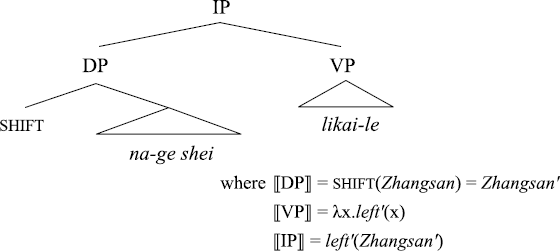
Cheung enriches the set of semantic types with the type for linguistic expressions, u. Then, the wh-word shei is treated as a predicate of type <u, t>, λx: ⟦x⟧ is a human under discussion. This function takes a linguistic expression x of type u and returns the statement that ⟦x⟧, namely the denotation of x, is a human under discussion. Na-ge is treated as a variant of the Russellian definite operator, taking a predicate of type <u, t> and returning the unique x such that x satisfies the description. The relevant semantic composition is shown in (24).
- (24)
- =
- =
- ⟦na-ge⟧(⟦shei⟧)
- ⟦na-ge⟧(λx: ⟦x⟧ is a human under discussion)
- the unique expression x such that
- the denotation of x is a human under discussion
In (22), ⟦na-ge⟧(⟦shei⟧) outputs the linguistic expression Zhangsan, and the null operator shift turns Zhangsan into its denotation Zhangsan′. Finally, Zhangsan′ combines with the denotation of VP, giving rise to the semantic representation of the whole clause: left′(Zhangsan′).
A potential problem with this type of analysis is how it would handle our data in Japanese, French, and German. One could argue that NPI-licensing may be ensured by postulating a target form involving a negator (or a neg feature) in a syntactic structure so that it c-commands the NPI before the semantic compositions begin. This analysis, however, is not straightforwardly applicable to the gender-mismatch data since a stipulation would have to be made that when a target form is introduced to a syntactic structure, its gender information (e.g. a gender feature) is not posited (or somehow removed after the target form is introduced). This, then, leads to the following ambivalent situation: a negator (or a neg feature) must be present to license an NPI, whilst a gender feature must be absent to prevent gender inconsistency.
We do not claim that this issue cannot be overcome within the standard syntactic/semantic framework. Given the vast amount of extant syntactic/semantic work in mainstream generative grammar, one could make use of some previous mechanism to account for the data. For instance, it might be possible to complement Cheung’s analysis with a device for gender mismatches in other phenomena such as ellipsis (Merchant 2014). Our claim, then, is modest; we will show that if we adopt the Dynamic Syntax view of grammar, we can readily and naturally account for a wide range of cases, including examples like (21), the NPI data, and the gender-mismatch phenomena, and as a bonus of this approach, we can extend the analysis to dialogic properties of PHs.
It should be emphasised that we will not propose an entirely new approach; our account rests on the conventional machinery of Dynamic Syntax. What we newly propose is the general parse-mechanism for PHs (see the end of Section 5.1), and even this new addition is based on the established apparatus of the framework: (i) the postulation of a meta-variable and its subsequent update, (ii) structural underspecification, and (iii) LINK relations. Therefore, our account, to be developed in the rest of this article, should not be taken as an analysis specifically tailored for PHs that relies on new theoretical tools.
4 Formal background
Some architectural features of Dynamic Syntax (DS) are briefly presented below (Kempson et al. 2001; 2011; 2016; Cann et al. 2005; Howes & Gibson 2021). Section 4.1 elaborates on these points by presenting a DS grammar of Japanese, and Section 4.2 extends it to French.
As a string of words is parsed time-linearly, a structure is constructed incrementally and monotonically.
This structure is conceptual; no separate level of syntactic structure is posited. A grammar is construed as the set of actions to build up a conceptual structure.
4.1. Basic architecture
In DS, the dynamicity, i.e. constant change, of structure building is explicitly modelled in the time-linearity of parsing. For example, the parse of (25) builds up a conceptual representation incrementally and monotonically, as displayed in (26).
- (25)
- Ken-ga
- Ken-nom
- hashit-teiru.
- run-ipfv
- ‘Ken is running.’ [Japanese]
- (26)
- a.
- Initial state

- b.
- Parsing Ken-ga

- c.
- Parsing Ken-ga hashit-

- d.
- Final state (ignoring tense/aspect)

The structures in (26) are conceptual; each node, once fully developed, accommodates semantic content (e.g. run′) and its semantic type (e.g. e→t).6 Each tree in (26), except for the final state, forms a partial structure in that it contains “requirements” such as ?t, which indicates that this node should be eventually annotated (“decorated”) with semantic content of type t. The tree transitions model monotonic information growth in that once a structure is built, it will not be destroyed and the information on tree nodes will be preserved.
A tree is gradually updated by lexical, computational, and pragmatic actions. We illustrate lexical and computational actions by explicating the tree transitions in (26). (Pragmatic actions will be illustrated later; see (36) below.) The initial state in (26)a is repeated here as (27) with a symbol ♢, called a pointer. In each state, the pointer ♢ marks the node under development, indicating where the next step in the parse process will take place.
- (27)
- Initial state
- ?t,
- ♢
The first word to be parsed is Ken, whose lexical entry is formulated as in (28).
- (28)
- Entry for Ken
- IF
- THEN
- ELSE
- ?e
- put(Ken′ : e)
- abort
The IF-line sets an input condition. In (28), it states that the current node (marked with ♢) should be decorated with ?e. If this condition is met, the parser looks at the THEN-line, which instructs the parser to decorate the node with the annotation Ken′ : e, an abbreviation standing here for an individual (indicated by the type annotation e) represented by the constant Ken′, which picks out the contextually accessible individual named Ken. Otherwise, the parser looks at the ELSE-line, which aborts the parse. Notice that the tree state in (27) does not contain a node decorated with ?e. The parser may predict such a node by creating it through the computational set of actions (a so-called “macro”) of Local *Adjunction.
- (29)
- Local *Adjunction

This macro of actions introduces an “unfixed” node, a node whose structural position in the tree is not yet determined and will be resolved later. This structural underspecification is visually shown by a dashed line in (29). The unfixed node introduced by Local *Adjunction must be resolved within a local propositional structure, but at the stage of (29), the parser is not sure about the exact position where the unfixed node will be resolved.7 Now that the tree in (29) has a node decorated with ?e, the action in the THEN-line of (28) is licensed to be executed with the result shown in (30).
- (30)
- Parsing Ken

The lexical macro encoded in the nominative particle -ga then specifies that the mother of the unfixed node is the root node (Cann et al. 2005: 254). As a result, the unfixed node is identified as the subject node, as in (31).
- (31)
- Parsing Ken-ga

What comes next is the intransitive verb hashit- ‘run’, which constructs a predicate node and decorates it with the content–type pair run′ : e→t.
- (32)
- Parsing Ken-ga hashit-

The current tree licenses functional application and type deduction. This is formulated as the computational macro of Elimination.
- (33)
- Elimination

Setting aside tense and aspect (see Cann 2011), the tree in (33) is in the final state, where the root node represents the truth-conditional content of (25): ‘Ken is running.’
In the above illustration, one may have had the impression that hashit- ‘run’ only creates a predicate node, but this is technically not true. To clarify this point, consider (34).
- (34)
- Hashit-teiru.
- run-ipfv
- ‘(A contextually salient person) is running.’ [Japanese]
Japanese is a pro-drop language, and argument NPs may drop as long as they are contextually recoverable. To model this pro-drop phenomenon, DS assumes that verbs and adjectives in Japanese encode the actions to construct a schematic propositional structure. Thus, the parse of hashit- in (34) updates the initial state in (27) into (35).
- (35)
- Parsing Hashit-

The subject node in (35) is decorated with a meta-variable U. Meta-variables in DS are values that do not belong to the object language in which the semantics of natural languages is expressed. Instead, they serve as a temporary label until an appropriate value from the object language becomes available. Such values can either be provided by processing further linguistic input (for example, in cases of cataphora) or through a pragmatic process of context search for accessible semantic values. Here, the meta-variable U is pragmatically assigned a value from the accessible context (the “common ground” (Clark 1996)), such as Ken′.8 This is an instance of the pragmatic macro called Substitution.
- (36)
- Substitution

In (31) earlier, the subject node has been introduced before hashit- ‘run’ is parsed. This does not create a duplication problem due to the “model-theoretic” formulation of DS as a grammar formalism (as opposed to a “generative-enumerative” formulation; see, e.g., Pullum & Scholz 2001). As long as the annotations on a node are compatible, the node can be updated with more informative values. Here the subject node created by hashit-, which is decorated with a meta-variable, harmlessly collapses with the pre-existing subject node as they are both defined as occupying the same position as the left daughter of the root node of a binary tree. The decorations on the nodes then collapse too, since the term Ken′ can update the underspecified meta-variable U with a fully specified value. The entry for hashit- is explicated in (37).
- (37)
- Entry for hashit- ‘run’
- IF
- THEN
- ELSE
- ?t
- make/go(↓0); put(U : e); go(↑0);
- make/go(↓1); put(run′ : e→t)
- abort
In (37), make/go(↓0) creates an argument-daughter node and moves the pointer ♢ to this node; go(↑0) moves the pointer ♢ back to the mother node; make/go(↓1) creates a functor-daughter node and moves the pointer ♢ to this node.
Finally, we introduce the mechanism of LINK. So far, a single tree has been built up at a time, but DS allows a pair of trees to be constructed in tandem via a formal relation called LINK. The LINK device has been applied to various phenomena such as relatives, left dislocations, co-ordinations, and topic constructions (Cann et al. 2005: chs. 3–6). For example, the parse of the topicalised element Ken-wa in (38) is modelled as in (39).
- (38)
- Ken-wa
- Ken-top
- yasashii.
- kind
- ‘Ken is kind.’ [Japanese]
- (39)
- Parsing Ken-wa

A LINK relation starts from a tree that has been constructed to another tree that will be built up with the first tree as context. In (39), the LINK relation starts from the type-e node to the type-t-requiring node, and the latter will be developed by the parse of the rest of the sentence: yasashii ‘kind’. The parse of yasashii builds a schematic propositional structure with a subject meta-variable; with the initial tree (i.e. the node decorated with Ken′) as context, this meta-variable pragmatically receives the value Ken′ (Substitution). After functional application and type deduction are performed (Elimination), the tree is updated to (40), where the paired trees share the term Ken′.9
- (40)
- Parsing Ken-wa yasashii + Substitution + Elimination

In (40), the LINK relation associates a type-e node to a type-t node, but LINK relations are free from type restrictions. In Section 5.1, we will discuss a LINK relation that relates a type-e node to another type-e node.
This subsection has outlined a DS grammar for Japanese. For more details, the reader is referred to Cann et al. (2005: ch. 6), Kempson & Kiaer (2010), and Seraku (2013).
4.2. Crosslinguistic universals and variations
In DS, crosslinguistic universals are mostly formulated as the set of computational macros (e.g. Elimination), whilst crosslinguistic variations are formulated as the set of lexical macros. The reason why we added the proviso mostly with regard to crosslinguistic universals is that not all computational macros are available across languages. As mentioned in Section 4.1, in Japanese, a propositional structure is lexically built up. This is true of other pro-drop languages such as Greek (Chatzikyriakidis 2012: 650) and Spanish (Bouzouita 2008: 249). By contrast, in French, a non-pro-drop language, a propositional structure is constructed by the computational macros called Introduction/Prediction (Cann et al. 2005: 44). For example, before initiating the processing of each word in (41), the parser performs Introduction/Prediction to construct a tree structure appropriately prepared to accommodate a subject–predicate structure in the semantic object language, as shown in (42).
- (41)
- Ken
- Ken
- court.
- run
- ‘Ken is running.’ [French]
- (42)
- Introduction/Prediction

Now that a skeletal structure is established, Ken decorates the current node with Ken′ : e, and court annotates the predicate node with the decoration run′ : e→t. The tree in (43) will reach the final state with the application of Elimination.
- (43)
- Parsing Ken court

Since a propositional structure is lexically constructed in pro-drop languages, the computational macros of Introduction/Prediction are not relevant to such languages.
Another crosslinguistic variation pertinent to the present study is concerned with gender agreement. Consider (44).
- (44)
- Leo
- Leo
- utilise
- use
- un
- a.mas
- détergent.
- detergent.mas
- ‘Leo uses a detergent.’ [French]
After the Introduction/Prediction macros are executed, Leo decorates the subject node. Since utilise ‘use’ is a transitive verb, it introduces a more complex structure than an intransitive on the binary tree: the “?e→t”-node is expanded with two daughters whose combination will derive the value needed to combine with the subject. So, an object and another predicate node are introduced by the actions of the verb with the pointer ♢ left at the object node anticipating the actions of the lexical entries that will introduce a semantic value on this node. The next word to be processed is the masculine article un, which introduces the requirement ?MAS at the object node, standing for a constraint that the semantic value to occupy this node needs to be contributed by a lexical entry that can satisfy the morphological feature ‘masculine’ (MAS):10
- (45)
- Parsing Leo utilise un
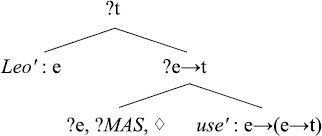
The current node is then decorated by the lexical entry for détergent, which introduces not only the usual content–type pair detergent′ : e but also contributes the feature MAS, which allows the requirement ?MAS to be satisfied and removed.
- (46)
- Parsing Leo utilise un détergent
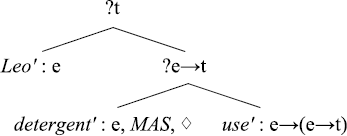
If the feminine article une were parsed in lieu of un in (44), the object node would be decorated with ?FEM(inine), but this requirement cannot be met by the masculine noun détergent. This is tantamount to what is descriptively called an agreement failure.
We have only sketched a DS grammar of French, but this suffices for our analysis of PHs. It is left for future research to develop a full-fledged grammar of French.11
5 Formal account
5.1. Proposal
As has been illustrated in Sections 2–3, PHs can be taken as referring expressions, albeit possibly with meta-linguistic reference (for further such cases and their treatment in DS, see, e.g., Gregoromichelaki 2017). For this reason, we hold that PHs also introduce a meta-variable in the developing conceptual representation. More specifically, we assign whatchamacallit the entry in (47), where PHwhatchamacallit is a meta-variable introduced by whatchamacallit.12
- (47)
- Entry for whatchamacallit
- IF
- THEN
- ELSE
- ?e
- put(PHwhatchamacallit : e)
- abort
This lexical entry is illustrated with (48) (= (1)).
- (48)
- [Naomi needs a pair of scissors to open a box. She is trying to ask Ken, her flatmate, to find it for her, but the expression a pair of scissors temporarily eludes her.]
- I need a whatchamacallit…, a pair of scissors.
The parse of I need a whatchamacallit in (48) constructs the tree in (49). (The meta-variable of the first-person pronoun I has been contextually updated as Naomi′.)
- (49)
- Parsing I need a whatchamacallit
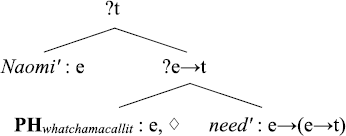
Given the DS machinery outlined in Section 4.1, there are two ways in which PHwhatchamacallit may be resolved: parsing the target form a pair of scissors on an unfixed node or on a LINKed node.
The first strategy is to introduce an unfixed node and parse a pair of scissors there. This process is illustrated in (50). In English, an unfixed node is introduced by *Adjunction (Cann et al. 2005: 61; see also footnote 7), but the unfixed node in (50) is different from an unfixed node introduced by *Adjunction.13
- (50)
- Parsing I need a whatchamacallit…, a pair of scissors

The parser may resolve the unfixed node by running Merge. This computational macro merges an unfixed node of semantic type α with a fixed node of the same semantic type α, to the effect that their node descriptions are unified (Cann et al. 2005: 65). In (51), the unfixed node has been resolved as the object node through the application of Merge, and the meta-variable PHwhatchamacallit has received the value scissors′.
- (51)
- Merge
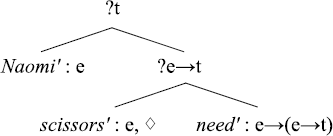
This tree leads to the final state in (52) with the applications of Elimination.
- (52)
- Elimination

The second strategy is to initiate a LINK relation from the object node in (49) to a type-e-requiring node and parse a pair of scissors on this LINKed node. This is illustrated in (53).
- (53)
- Parsing I need a whatchamacallit…, a pair of scissors
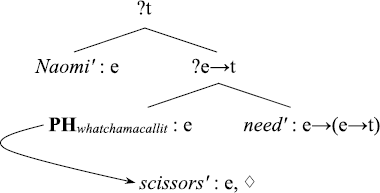
The LINK relation is then “evaluated” (see, e.g., Cann et al. 2005: 113): the content scissors′ is reflected in the object node, and PHwhatchamacallit is updated to scissors′. After Elimination is executed, the final state in (54) emerges.
- (54)
- Elimination

Though this is not evident in (52) and (54), the two parsing strategies may output distinct node descriptions. In the strategy involving an unfixed node, all node descriptions of an unfixed node (including a negation feature or a gender feature, if any) are reflected in a fixed node. In the strategy involving a LINKed node, only the semantic content on a LINKed node is passed on to the node from which this LINK relation is initiated. This difference in node descriptions is the key to explaining the NPI data in Japanese and the gender-mismatch data in French and German, as will be shown in Sections 5.2–5.4.
In (48), a PH is immediately followed by its target form, but our account also deals with cases where a PH and its target form occur across sentences. In such cases, the parser may put on hold the tree update for the PH-involving string and re-initiate it later once it encounters the target form. To this end, the parser needs to keep track of previous tree-updates; this is modelled in terms of a Directed Acyclic Graph (Sato 2011), as demonstrated in, e.g., Hough (2015: Sections 6.4–6.5).
Further, our account handles cases where a target form is absent on the surface. Recall that a DS structure is updated by both linguistic (i.e. lexical or computational macros) and non-linguistic actions (i.e. pragmatic macros). This means that the DS system is not “encapsulated” in the sense that the parser may employ non-linguistic information at any stage during structure building. Consider (55) (= (7)).
- (55)
- [Naomi has difficulty opening a box, and she talks to Ken, her flatmate.]
- I need a whatchamacallit.
If the hearer presumes that Naomi refers to a pair of scissors, the parser may execute the actions encoded in the expression a pair of scissors by introducing an unfixed node or a LINKed node. In either case, the meta-variable provided by whatchamacallit is resolved. It is also possible that the hearer only has in mind a vague concept such as ‘a tool for opening a box’ without thinking of a specific linguistic item. In this case, the parser can retrieve and introduce this “ad hoc” concept (Carston 2002: ch. 5) since such concepts are, in fact, the eventual inhabitants of tree nodes in DS.14 This process updates (49) into (56), where the ad hoc concept ‘a tool for opening a box’ is notated as tool′.
- (56)
- Substitution
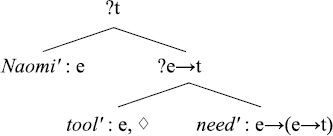
The tree in (56) is mapped onto the final state in (57) with the applications of Elimination.
- (57)
- Elimination
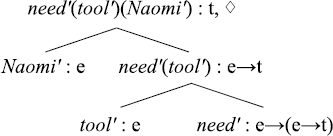
The proposal made in this subsection is summarised in the bullet points below. These will be applied to various examples in Japanese, French, German, and some other languages in the ensuing subsections.
A PH introduces a meta-variable PH with appropriate semantic restrictions.15
When a target form is present in the string, the parser may resolve a PH meta-variable by parsing the target form on an unfixed node or a LINKed node.
When a target form is absent in the string, the parser may (i) run the actions encoded in a contextually available target form on an unfixed node or a LINKed node or (ii) construct an ad hoc concept and replace a PH meta-variable with it.
5.2. Japanese
The entry for the nominal PH are is specified in (58).
- (58)
- Entry for the nominal PH are
- IF
- THEN
- ELSE
- ?e
- put(PHare : e)
- abort
We do not formalise the semantic restrictions on the use of are; hence, the informal notation PHare. The lexical entry in (58) is illustrated with (59) (= (4)).
- (59)
- [The speaker, who is delivering a linguistics presentation, answers a question from the floor, saying that the example offered by the questioner is irrelevant to his main point.]
- Kore
- this
- shugo-desu-yone.
- subject-cop-fp
- Desukara
- so
- maa
- intj
- ano
- intj
- bunpootekina
- grammatical
- ano
- intj
- are-ga
- ph-nom
- kinoo-ga
- function-nom
- chotto
- somewhat
- chigau-ndesu-keredomo
- differ-mm-but
- […]
- ‘This (i.e. the phrase you mentioned) is a subject, isn’t it. So, the grammatical ph (= function) is different, but…’ [Japanese (CSJ)]
Setting aside desukara ‘so’ and bunpootekina ‘grammatical’,16 the parse of are-ga yields the tree in (60) through a step of Local *Adjunction.
- (60)
- Parsing Are-ga

The target form kinoo ‘function’ is then parsed on an unfixed node or a LINKed node. In either case, PHare is resolved as function′, as shown in (61).17
- (61)
- Resolution of PHare

The rest of the process is as outlined in Section 4.1. The parse of chigau- ‘differ’ constructs a propositional skeleton, and Elimination performs functional application and type deduction.
The treatment of predicative PHs is more complex because Japanese verbs and adjectives are assumed to build a propositional structure. Consider (62)–(63).
- (62)
- Entry for the verbal PH aresuru
- IF
- THEN
- ELSE
- ?t
- make/go(↓0); put(U : e); go(↑0);
- make/go(↓1); put(PHaresuru : e→t)
- abort
- (63)
- Entry for the adjectival PH aredesu
- IF
- THEN
- ELSE
- ?t
- make/go(↓0); put(U : e); go(↑0);
- make/go(↓1); put(PHaredesu : e→t)
- abort
For instance, suppose that aredesu is parsed sentence-initially. (Recall that Japanese is a pro-drop language.) The lexical actions specified in (63) construct the tree in (64).
- (64)
- Parsing Aredesu

As has been explained with regard to (37), make/go(↓0) creates an argument-daughter node and moves the pointer ♢ to this node; put(U : e) decorates this node with U : e; go(↑0) moves the pointer ♢ to the mother node; make/go(↓1) creates a functor-daughter node and moves the pointer ♢ to this node; put(PHaredesu : e→t) decorates this node with PHaredesu : e→t.
The entry for aredesu is more concretely illustrated with (65).
- (65)
- Naomi-ga
- Naomi-nom
- aredesu…,
- ph
- kireidesu.
- beautiful
- ‘Naomi is ph…, beautiful.’ [Japanese]
First, Local *Adjunction creates an unfixed node, which is decorated by Naomi and resolved as the subject node by the nominative -ga. Second, aredesu constructs a propositional template and posits PHaredesu : e→t on the predicate node. The subject meta-variable in this propositional template harmlessly collapses with the content of the pre-existing subject node, Naomi′ (see the discussion about (36)).
- (66)
- Parsing Naomi-ga aredesu

The parser then processes the target form kireidesu ‘beautiful’ on an unfixed node or a LINKed node, and PHaredesu is updated to the fully specified content beautiful′.
- (67)
- Parsing Naomi-ga aredesu…, kireidesu

The entry for aredesu in (63) accounts for the NPI data in (68) (= (9)).
- (68)
- [Two females are talking about a famous male TV personality in Japan.]
- Anmari
- much.npi
- shaberu-no-ga
- talk-nmls-nom
- aredesu-yone.
- ph-fp
- Kooiu
- this.kind
- baraetii-de
- variety.programme-in
- shaberi-soona
- talk-seem
- kanji-ja-nai-desu-yone.
- feeling-cop-neg-hon-fp
- ‘He (= the famous TV personality) is much ph (= e.g. not good at) talking, isn’t he. He doesn’t look like a person who talks a lot in this kind of variety programme, does he?’ [Japanese (CSJ)]
Cann et al. (2005: 216) assign the NPI any an entry whose input condition is that the root node should be decorated with the feature NEG. For Japanese anmari, we assume that the root node is decorated with the requirement ?NEG because in Japanese, a negator comes towards the end of a clause. Thus, the parse of anmari in (68) outputs (69).
- (69)
- Parsing Anmari
- ?t, ?NEG, ♢
Then, after Local *Adjunction induces a type-e-requiring unfixed node, shaberu-no ‘talking’ decorates this unfixed node and -ga resolves it as the object node, as shown in (70).18 In this partial structure, the object node is designated as the one whose mother is the functor-daughter of the root node, as decorated with ?e→t.
- (70)
- Parsing Anmari shaberu-no-ga
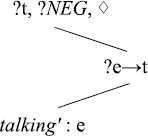
Now, the adjectival PH aredesu constructs a propositional skeleton and decorates the predicate node with PHaredesu : e→t.
- (71)
- Parsing Anmari shaberu-no-ga aredesu
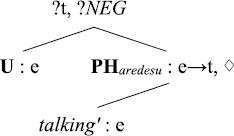
In (68), a target form is absent on the surface, but given that a DS grammar is non-encapsulated, the hearer may be able to recover the form tokuija-nai-desu ‘good.at-neg-hon’ as a potential target form. The parser may then execute the associated actions in the lexical entry, creating a propositional template. If the parser runs these actions on an unfixed node, the tree in (72) arises. In (72), a type-t-requiring unfixed node has been introduced because tokuija-nai-desu is a predicate and can be parsed only on a type-t-requiring node. The parse of tokuija-nai-desu has created a schematic propositional structure, where the top node, marked with the pointer ♢, is decorated with NEG due to the negator -nai.
- (72)
- Running the actions encoded in tokuija-nai-desu
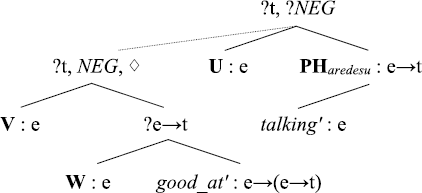
In the current propositional structure, the meta-variables V and W are contextually updated to TVP′ (denoting the TV personality in question) and talking′, respectively (Substitution), and functional application and type deduction are then performed (Elimination).
- (73)
- Substitution + Elimination
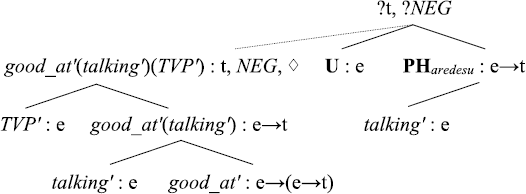
The tree in (73) licenses Merge, which unifies the information on the type-t unfixed node with that on the type-t-requiring fixed node. Consequently, U is updated to TVP′, and PHaredesu to good_at′(talking′). And crucially, the requirement ?NEG is satisfied by NEG.
- (74)
- Merge
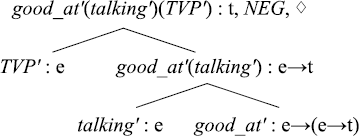
The NPI data are thus properly modelled based on the unfixed-node approach. On the other hand, if a LINK relation is launched, its evaluation process reflects only the semantic content (but not the feature NEG) in the main tree, and the requirement ?NEG remains unfulfilled. Therefore, the NPI data are accounted for only through the introduction of an unfixed node.
In closing, let us consider why the verbal PH aresuru cannot substitute for a negated expression, as illustrated in (75) (= (11)).
- (75)
- *Kinoo-wa
- yesterday-top
- anmari
- much.npi
- areshi-ta-yo…,
- ph-pst-fp
- etto…,
- well
- ne-nakat-ta-yo.
- sleep-neg-pst-fp
- Int. ‘I ph-ed much yesterday…, well…, didn’t sleep much.’ [Japanese]
In Japanese, when an adjective is negated, the negator -nai comes before -desu, as in kireija-nai-desu ‘beautiful-neg-hon’. Note that -desu is a constituting part of the PH aredesu. That is, the negator -nai is included in the range of sequence to be substituted for by the PH aredesu. By contrast, when a verb is negated, -nai comes after the verb, as in ne-nai ‘sleep-neg’. Since the verbal part of aresuru is -suru, the negator -nai is not included in the range of sequence to be substituted for by the PH aresuru. This is why aresuru cannot substitute for a negated verb. In fact, if -nai is put after the verbal part -suru in aresuru, the extended PH form areshi-nai ‘ph-neg’ substitutes for a negated verb, as shown in (76), where areshi-nai is realised as areshi-nakat before the past tense marker -ta.
- (76)
- Kinoo-wa
- yesterday-top
- anmari
- much.npi
- areshi-nakat-ta-yo…,
- ph-neg-pst-fp
- etto…,
- well
- ne-nakat-ta-yo.
- sleep-neg-pst-fp
- ‘I didn’t ph much yesterday…, well…, didn’t sleep much.’ [Japanese]
5.3. French
French truc and machin are assigned the entries in (77)–(78).
- (77)
- Entry for the nominal PH truc
- IF
- THEN
- ELSE
- ?e
- put(PHtruc : e, MAS)
- abort
- (78)
- Entry for the nominal PH machin
- IF
- THEN
- ELSE
- ?e
- put(PHmachin : e, MAS)
- abort
As pointed out in Section 3.2, truc and machin exhibit semantic idiosyncrasies. For instance, truc is usually not used for humans (see (14)). Again, these idiosyncrasies are not addressed here. Of particular note in (77)–(78) is the THEN-line, where the feature MAS is introduced, reflecting the masculine gender of truc and machin.
Consider (79) (= (12)).
- (79)
- [Emma wants to use a washing machine and needs a detergent. She asks Leo about its whereabouts, but she cannot remember the word détergent ‘detergent’.]
- J’ai
- I.have
- besoin
- necessity
- du
- of.the.mas
- truc/machin
- ph
- pour
- for
- laver
- wash
- le
- the
- linge.
- laundry
- ‘I need a ph (= detergent) to wash the laundry.’ [French]
After the parse of J’ai besoin du truc, the tree in (80) emerges.
- (80)
- Parsing J’ai besoin du truc
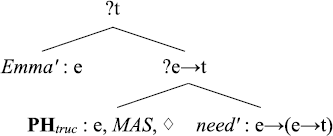
The current node is decorated with MAS, which satisfies the requirement ?MAS, posited by du. If the parser runs the actions encoded in the target form détergent on an unfixed node, the tree in (80) is updated into (81).
- (81)
- Running the actions encoded in détergent

This tree licenses Merge, unifying the information on the unfixed node with that on the object node. PHtruc is then updated to detergent′, and MAS is reflected in the object node. Since the object node has already been decorated with MAS, this additional introduction of MAS does not alter the node description.
- (82)
- Merge
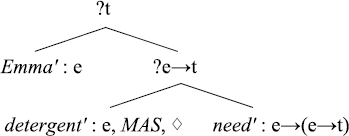
Alternatively, at the stage of (80), one could induce a LINKed node to run the actions encoded in détergent. The evaluation of this LINK relation reflects the content detergent′ (but not the feature MAS) in the object node, and PHtruc is resolved as detergent′. In either case, example (79) is appropriately modelled.
The present account naturally deals with the mismatch data in (83) (= (15)).
- (83)
- [Emma is fixing a clock with a screw, but the screw is too small. So, she wants Leo to give her a bigger one, but she cannot remember the form vis ‘screw’ and its gender.]
- J′ai
- I.have
- besoin
- necessity
- d’un
- of.a.mas
- plus
- more
- gros
- big.mas
- truc/machin
- ph
- (ah
- (ah
- oui…,
- yes
- vis).
- screw.fem)
- ‘I need a bigger ph (…, ah yes…, screw).’ [French]
The parse of J′ai besoin d′un truc (excluding plus gros ‘bigger’) outputs the tree in (84).
- (84)
- Parsing J′ai besoin d′un truc
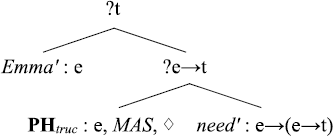
Suppose that the parser runs the actions encoded in the target form vis ‘screw’ on a LINKed node. Since the evaluation of the LINK relation reflects the content screw′, but not the feature FEM, in the object node, PHtruc is resolved as screw′ without inconsistency.
- (85)
- Parsing J′ai besoin d′un truc…, vis
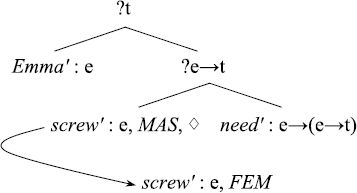
By contrast, if the parser runs the actions encoded in vis ‘screw’ on an unfixed node, the tree in (86) is constructed.
- (86)
- Parsing J′ai besoin d′un truc…, vis

After the application of Merge, the object node is decorated with not only screw′ but also FEM. As a result, feature inconsistency is detected, as highlighted in grey in (87). The current parse process, therefore, fails to derive a well-formed tree.
- (87)
- Merge

The upshot is that the gender-mismatch data are handled only through the introduction of a LINK relation.
As will be argued in the next subsection, the analysis of the French mismatch phenomena straightforwardly carries over to the German examples, but with a twist due to the genderless PH forms.
5.4. German
The lexical entry for German Dingens is formulated in (88).
- (88)
- Entry for the nominal PH Dingens
- IF
- THEN
- ELSE
- ?e
- put(PHDingens : e)
- abort
Unlike French truc and machin, Dingens is genderless. This is why the action in the THEN-line only introduces the usual content–type pair.
Let us illustrate this entry with (89) (= (17)).
- (89)
- [Hanna is fixing a clock with a screw, but the screw is too small. So, she wants Ben to give her a big screw. She knows that the word for a screw is feminine, but she cannot remember the form Schraube ‘screw’.]
- Ich
- I
- brauche
- need
- eine
- a.fem
- große
- big.fem
- Dingens.
- ph
- ‘I need a big ph (= screw).’ [German]
The parse of (89), excluding große ‘big’, engenders the tree in (90).
- (90)
- Parsing Ich brauche eine Dingens
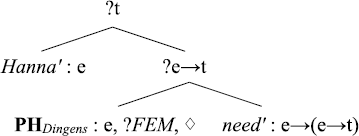
The presence of ?FEM is due to the feminine article eine ‘a’. Unlike French truc and machin, Dingens encodes no gender information; this is why ?FEM remains unfulfilled at this stage. If the parser executes the actions encoded in the target form Schraube ‘screw’ on an unfixed node and this unfixed node unifies with the object node (Merge), PHDingens is resolved as screw′ and FEM is introduced. The latter satisfies ?FEM.
- (91)
- Running the actions encoded in Schraube ‘screw’ + Merge
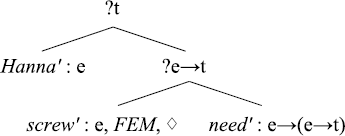
Alternatively, the parser could run the actions encoded in Schraube on a LINKed node. In this case, however, the evaluation of the LINK relation only reflects the content screw′ (but not the feature FEM) in the object node, and ?FEM remains unfulfilled.
We turn to our crucial example (92) (= (19)).
- (92)
- [Hanna is fixing a clock with a screw, but the screw is too small. So, she wants Ben to give her a big screw, but she cannot recall the word for a screw and its gender.]
- Ich
- I
- brauche
- need
- ein
- a.neut
- großes
- big.neut
- Dingens
- ph
- (…,
- (
- ähm…,
- well
- Schraube).
- screw.fem)
- ‘I need a big ph (…, well…, screw).’ [German]
We assume that the neuter forms such as ein ‘a’ and großes ‘big’ introduce the NEUT feature.19 With this assumption, the parse of (92), excluding großes ‘big’, builds the tree in (93).
- (93)
- Parsing Ich brauche ein Dingens
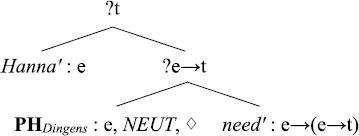
If the parser runs the actions encoded in the target form Schraube ‘screw’ on a LINKed node, the evaluation of the LINK relation reflects screw′ (but not FEM) in the object node. Thus, no inconsistency is detected in the node description. By contrast, if the parser executes the actions encoded in Schraube on an unfixed node and this unfixed node unifies with the object node, the object node is newly decorated with screw′ and FEM. This leads to inconsistency because the object node ends up accommodating NEUT and FEM.
In sum, only the LINK-based parsing derives a well-formed tree for the gender-mismatch data in French and German. Although the analysis of French PHs differs from that of German PHs in terms of gender specifications of PH forms, they both rely on the central DS machinery: the introduction of a meta-variable and its subsequent update through a LINK relation.20
5.5. Further crosslinguistic applications
Up until now, our discussion has centred around English, Japanese, French, and German, but PHs are widely observed in the languages of the world, such as the nominal PH ceke (< ‘that’) in Korean (Hayashi & Yoon 2006: 492), the verbal PH cosare (< cosa ‘thing’) in Italian (Podlesskaya 2010: 15), and the adjectival PH ini (< ‘this’) in Indonesian (Wouk 2005: 246). In our account, these PHs encode a meta-variable of appropriate semantic type, such as PHini : e→t for the adjectival PH ini in Indonesian.
A noteworthy case is kua in Ilocano (Austronesian), which substitutes for a wide array of elements such as a noun, a verb, an adjective, an adverb, and a clause (Rubino 1996: 657–659). In (94), kua substitutes for a clause.
- (94)
- [The speaker is talking about seeing her dead friend’s ghost.]
- bigat-en
- morning-cmpl.asp
- a-
- ptcl
- nga
- lig
- kua-n,
- ph-ptcl
- naka-riing
- adj.cmpl.asp.intr-wake.up
- kano-n.
- hrs-ptcl
- ‘It was morning, when ph…, they said she woke up.’ (Rubino 1996: 659) [Ilocano]
A possible solution to this versatile PH is to assign it an entry with type underspecification.
- (95)
- Entry for the PH kua
- IF
- THEN
- ELSE
- ?α
- put(PHkua : α)
- abort
- where each instance of α stands for
- the same element of {e, t, e→t}
When kua stands for a clause, as in (94), the decoration PHkua : t is selected. When kua stands for an adverb, we simply follow Marten’s (2002) type-e analysis. (Alternatively, we could adopt a situation-term analysis of adverbs; see Gregoromichelaki 2006.)
Another challenge to our account is posed by (96).
- (96)
- Ao-shenme-de
- Hollande
- shi
- be
- xianren
- current
- Faguo
- France
- zongtong
- President
- ‘Ao-ph-de is the current President of France.’ (Cheung 2015: 276) [Mandarin]
The speaker cannot fully recall the proper name Ao-lang-de, a Mandarin translation of Hollande, and replaces its intermediate syllable with the PH shenme (< ‘what’). Since DS tree transitions are triggered by morphemes, not by phonemes, (96) is problematic (see Sailer & Dörne 2021: 143 for similar data in German). In order to accommodate such examples, we need to establish the phonology–grammar interface in DS, which goes far beyond the scope of the present work (see Cann 2021 for preliminary remarks).
6 Extension
6.1. PHs in dialogue
Since PHs typically occur in talk-in-interaction, they are often used as a grammatical resource for achieving a speaker–hearer joint action: a speaker may produce a PH and invite a hearer to search for a target word collaboratively. Such dialogic functions are associated with the uses of PHs in various languages, such as Japanese are (Kitano 1999: 388), Korean kuke (Kim & Suh 2002: 193–197), Romani kako (Matras 1998: 422), and Estonian see (Keevallik 2010: 157). A case pertaining to Japanese are is presented in (97).
- (97)
- [N and A are talking about the novels that they have recently read.]
- 1
- N:
- Sooieba,
- that.reminds.me
- are
- ph
- omoshiroi-njanai-no?
- interesting-mm-q
- ‘That reminds me, isn’t ph interesting?
- 2
- Nanka,
- like
- ano=.
- um
- ‘Like, um.’ (‘=’ is a transcription symbol for sound lengthening)
- 3
- A:
- Tokuzawa
- Tokuzawa
- keeji
- detective
- shochoo.
- police.department.chief
- ‘PD Chief Tokuzawa?’
- 4
- N:
- Chau
- no
- chau
- no
- chau.
- no
- ‘No, no, no.’
- 5
- Ano,
- um
- Hotta
- Hotta
- Tsutomu-ga
- Tsutomu-nom
- kaita,
- wrote
- “hinin”-teyuuno.
- “denial”-something.called
- ‘Um, the one (novel) called Denial that Hotta Tsutomu wrote.’ (Kitano 1999: 388) [Japanese]
In line 1, speaker N utters are presumably because the title of a novel temporarily eludes him. This instance of are is followed by two interjective fillers nanka ‘like’ and ano ‘um’, and then speaker A provides a candidate for the referent of are. Though A’s guess turns out to be wrong (see line 4), what is important here is that N’s use of are may be seen as an invitation to A for joining N’s word-search. Also, line 3 reveals a further characteristic property of dialogue: a participant’s contribution may be nonsentential.
As another example, consider Estonian see in (98).
- (98)
- [M and L take the same course at a university. In the current excerpt, they are talking about what will be the most important thing for their upcoming exam.]
- 1
- M:
- .hh
- a
- but
- kõige
- most
- tähtsam
- important
- on
- is
- see:: -
- ph
- ‘But the most important thing is ph::’
- 2
- (0.8)
- 3
- L:
- ajalugu.=
- ‘History.’
- 4
- M:
- =e jah,
- ‘yeah.’ (Keevallik 2010: 157) [Estonian]21
This example uncovers another feature of dialogue. In line 1, speaker M produces the PH see, and speaker L (who was a hearer in line 1) offers a candidate for the referent of see in line 3, which is immediately acknowledged in line 4 by speaker M (who was a hearer in line 3). That is, a speaker–hearer switch takes place seamlessly and fluently during an ongoing interaction. Further, as shown in lines 1–3, a speaker–hearer switch may occur mid-sententially.
These dialogic phenomena (i.e. the use of nonsententials, speaker–hearer joint actions, mid-sentential speaker–hearer switches) have been generally seen as something in the realm of language performance, except for some cases of nonsententials (Barton 1990; Merchant 2004; Progovac et al. 2006). On the other hand, these dialogic features fall in the scope of DS, which analyses a string of words uttered and interpreted time-linearly in context. In the next subsection, we will extend our account of PHs by applying the DS treatment of dialogue issues to the PH–dialogue phenomena (see Purver et al. 2014 for speaker–hearer joint actions and speaker–hearer switches and Gregoromichelaki et al. 2020 for nonsententials).
6.2. Analysis
Our presentation of DS has so far concentrated on parsing, which licenses the incremental construal of word-sequences in comprehension. However, DS models both parsing (comprehension) and generation (production) simultaneously and this provides the basis for accounting for dialogue phenomena like “split utterances” (see, e.g., Gregoromichelaki & Kempson 2013). In DS, parsing and generation use the same predictive and incremental mechanisms which is the reason for arguing that the grammar itself has the role of establishing and sustaining coordination between speaker and hearer in dialogue. The only difference between comprehension and production is that in the latter, the speaker is manipulating a “goal-tree” in addition to the common parse tree. The goal tree is possibly a partial tree (modelling the incrementality of production) but at least one processing step ahead of the parse tree. The goal tree represents the conceptual content the speaker plans to linearise verbally and it serves as a self-monitoring device in that the speaker constantly checks each tree state to ascertain that it “subsumes” the goal tree (“subsumption check”; see, e.g., Purver et al. 2006), with implicit or explicit self-repair ensuing otherwise. A tree is said to subsume a goal tree if it does not contain any nodes or node decorations absent in the goal tree. For illustration, Ken runs is incrementally parsed/generated as depicted in (99) (see also Purver & Otsuka 2003: 81).
- (99)
As can be seen in (99), the same set of mechanisms underlies parsing and generation, with the sole difference being that in the case of generation, each tree state undergoes a subsumption check against a goal tree and unsuccessful candidates are removed and not pursued further.
Let us now analyse (97). Prior to line 3, N and A have constructed the tree in (100), where PolQ is a feature introduced by the interrogative form of polar questions.
- (100)
- Parsing line 1 in (97) (excluding sooieba and -njanai)

At this stage, the tree update is incomplete in that PHare is not resolved and that the root node is decorated with ?t. The goal-tree, therefore, is the one identical to (100) except that PHare has been assigned a value and Elimination (i.e. functional application and type deduction) has been performed. In line 3, A updates (100) by resolving PHare through the parse of Tokuzawa keeji shochoo ‘PD Chief Tokuzawa’ on an unfixed node or a LINKed node, as shown in (101).
- (101)
- Parsing line 3 in (97)

Elimination then performs functional application and type deduction, yielding (102).
- (102)
- Elimination

Since the tree in (102) subsumes the goal-tree mentioned above, this generation step (i.e. the production of Tokuzawa keeji shochoo) is licensed. Note that participants N and A share the tree in (100) and that either N or A could have extended it by producing words. This is why the change in speakership is seamless in the course of talk-in-interaction.
As stated above, a goal-tree is an extension of a current tree, and a current tree may be a partial one. In the Estonian example (98), a speaker–hearer switch takes place in line 3, but at this point, M’s utterance in line 1 is incomplete, as indicated by sound lengthening. In DS terms, M and L set out a goal-tree relative to the partial tree for M’s incomplete utterance. In line 3, L employs this partial tree as a basis for the next generation step (i.e. the production of ajalugu ‘history’).
The upshot is that the PH-involving dialogue phenomena follow from a unified treatment of incremental comprehension and production. One might object that the successful modelling of dialogue data does not favour our account over previous ones, given that it is generally held that dialogue phenomena fall outside the scope of standard competence grammars. Still, a growing body of work has been carried out to develop grammatical frameworks that can handle dialogue data (Lücking et al. 2021). Furthermore, it is in principle possible even for standard competence frameworks to incorporate parsing incrementality (Phillips 2003), thus blurring the lines between competence and performance. From this point of view, it seems justifiable to argue that the modelling of the dialogic properties of PHs is a welcome and confirming consequence of our analysis.
7 Implications
In this paper, we have uncovered hitherto underdescribed PH data (especially, the gender-mismatch phenomena in French and German) and proposed a formally sound, realistic account. The account rests in the formally sound DS architecture which is underpinned by a customised Propositional Dynamic Logic and the Logic of Finite Trees (see, e.g., Kempson et al. 2001). The account is realistic in that it seeks to formalise the online time-linear parsing and generation of PH-involving utterances without abstracting away from the influence of context and, hence, also including modelling of the incremental contributions of participants in talk-in-interaction.
The proposed account has been applied to English, Japanese, French, and German (plus a few other languages), but its validity must be tested against a wider range of languages. PHs have been described relatively well in some languages such as English, Japanese, Korean, and Mandarin (e.g. Enfield 2003; Hayashi & Yoon 2006; Cheung 2015; Palacios Martínez & Núñez Pertejo 2015; Seraku et al. 2022), but there has still been a shortage of descriptive work on individual languages as well as crosslinguistic surveys. In particular, as has been pointed out in Section 3, French and German PHs have not been sufficiently described. In this regard, the present study has provided an array of new examples. As further empirical implications, it would be fruitful to describe various types of PH-involving agreement patterns (concerning not only gender but also case, number, and person) in a variety of languages and to consider whether any agreement mismatch is detected.
As theoretical consequences, we have made a case for a formal approach to PHs. Given that the use of a PH is often viewed as a linguistic manifestation of speech disfluency, failure in speech planning, avoidance of certain linguistic items, and various other performance factors, PHs have been considered peripheral expressions and have not been vigorously explored in the theoretical linguistics studies maintaining the competence/performance dichotomy (see Section 3.4 for a few exceptions). We have shown that PHs offer intriguing data worth investigating in formal-linguistic terms (e.g. the NPI data, the gender-mismatch data).
More broadly, linguistic properties of dialogue (e.g. the use of nonsententials, speaker–hearer switch, speaker–hearer joint action) have been disregarded in the literature of mainstream syntax/semantics, except for nonsententials (e.g. Merchant 2004; Progovac et al. 2006). Still, once grammar is conceived of as a non-encapsulated system in the light of syntax–semantics–pragmatics interactions online during processing, its application to dialogue phenomena is a natural consequence of grammar modelling. In this context, our account of PHs in talk-in-interaction is viewed as a case study of grammar-based approaches to dialogue, a topic that has recently been hotly debated (Lücking et al. 2021). It is hoped that our enquiry will further stimulate this grammar-for-dialogue enterprise.22
Abbreviations
1 = first person, acc = accusative, adj = adjective, asp = aspect, caus = causal, cl = clitic, clf = classifier, cmpl = completed, cop = copula, cvb = converb, dem = demonstrative, des = desiderative, dis = disfluency, fem = feminine, fp = final particle, gen = genitive, hon = honorific, hrs = hearsay, intj = interjection, intr = intransitive, ipfv = imperfective, lig = ligature, mas = masculine, mm = modal marker, neg = negation, neut = neuter, nmls = nominalisation, nom = nominative, npi = negative polarity item, pfv = perfective, ph = placeholder, pl = plural, pst = past, ptcl = particle, q = question marker, quot = quotation, sg = singular, top = topic
Notes
- Japanese demonstratives are tripartite, traditionally categorised into “proximal” (near speaker), “medial” (near hearer), and “distal” (away from speaker/hearer). Are is a pronominal demonstrative in the distal category. For Japanese demonstratives, see Takubo (2020) and references therein. [^]
- Japanese examples were created by the present author or collected from the Corpus of Spontaneous Japanese (CSJ; The National Institute for the Japanese Language and Linguistics). They were transcribed according to the Hepburn system, except that long vowels were notated as aa, ee, ii, oo, and uu. French and German examples were created by my consultants; see the Acknowledgements section. When examples were cited from previous studies, minor amendments were made for the sake of consistency. [^]
- As in the case of the NPI any, anmari is licensed under not only negation but also the antecedent of conditionals, before-clauses, etc. Unlike any, however, anmari is not licensed under questions and licensed in non-negated because-clauses (Matsui 2013: 302–303). [^]
- The Académie Française has decided that COVID-19 is feminine, but many people treat it as masculine (Jean-Baptiste Causse p.c., 12/Aug/2021). [^]
- It may also be worth mentioning Koev (2016), who examines Quotational Indefinites (QIs) in Bulgarian. QIs range over a linguistic expression in quoted speech and denote the content of the expression with a “reportative implication”. According to Koev, the QI edi-koj may be used when a speaker does not recall a particular linguistic expression. This use of edi-koj is functionally similar to the ability-related cases of PHs. Still, his analysis cannot be directly applied to PHs because (i) unlike QIs, PHs do not encode a reportative implication and (ii) unlike QIs, PHs are generally not structurally restricted to quotational environments. [^]
- The semantic formulae are terms in a typed lambda calculus. For simplicity of illustration purposes, lambda terms are shown without the lambdas, as in run′, rather than λx.run′(x). [^]
- Cann et al. (2005: 61, 236) define distinct types of macros to introduce a type-e-requiring unfixed node, such as *Adjunction and Local *Adjunction. Whilst Local *Adjunction allows an unfixed node to be resolved only within a local propositional structure, *Adjunction does not impose such a restriction. One could have used *Adjunction at the stage of (29), but this will eventually lead to the same tree as (31), because the unfixed node introduced by *Adjunction will also be identified as the subject node by the parse of the nominative particle -ga. [^]
- Formally, a meta-variable is coupled with the requirement that it should be assigned a value. This requirement is written as ?∃x.Fo(x), but it is omitted here (see Cann et al. 2005: 68). [^]
- Formally, the LINKed node in (39) is decorated with the requirement that a node somewhere below the current node should be decorated with Ken′. This requirement is written as ?<D>Fo(Ken′) in the Logic of Finite Trees (Blackburn & Meyer-Viol 1994). See Cann et al. (2005: 268–269) for details. [^]
- Un also encodes indefiniteness (see Cann et al. 2005: 107). This aspect of meaning is ignored here. [^]
- We do not develop a DS grammar of German here either. Whatever the correct modelling of German is, it should derive a propositional tree for the string parsed, and the mechanism for processing a PH, to be proposed in Section 5.1, is implemented over such a propositional tree. [^]
- Whatchamacallit refers to an inanimate entity, at least in its typical cases. This constraint is informally notated as PHinanimate_entity′ (see Cann et al. 2005: 71). Considering that there would be other semantic restrictions on the uses of whatchamacallit, which are not directly addressed here, we simply notate the meta-variable introduced by whatchamacallit as PHwhatchamacallit. [^]
- *Adjunction cannot be executed in (49) due to the restriction that it cannot be run if there exists a node below a type-t-requiring node (Cann et al. 2005: 61). Thus, we propose a distinct computational macro to introduce an unfixed node, as shown in (50). First, the aforementioned restriction is not imposed on this macro. Second, the macro may be executed only if there exists a PH meta-variable below the root node. (This restriction can be formulated with a modal operator in the Logic of Finite Trees (Blackburn & Meyer-Viol 1994).) This ensures that the macro may be used only when a PH has been parsed. Thus, one cannot run the macro to parse, for example, Naomi in the string Ken, Naomi likes (see Cann et al. 2005: 66–67 for related discussion). [^]
- As Gregoromichelaki & Kempson (2019) argue, the tree nodes of DS structures are inhabited by ad hoc concepts, rather than simply semantically encoded concepts, even when there is a word in the language that gives access to a specific conceptualisation of an entity or event. Therefore, provided that non-linguistic information is available in the context, a hearer will be able to introduce such an ad hoc concept in the emerging structure whether there is a particular word in the language that a speaker is unable or unwilling to produce or not. I owe this point to an insightful comment from an anonymous reviewer. [^]
- As stated in Section 2, the use of a PH is associated with a speaker’s abilities or preferences. In this respect, PHs are distinguished from pronouns and other referring expressions. We hold that the notions of abilities and preferences are not encoded in PH forms because they are captured in terms of the presumption of optimal relevance (Sperber & Wilson 1995: 270), as argued in Seraku (2022a). An anonymous reviewer is thanked for their comment that led to clarification of this point. [^]
- In DS, discourse connectives are analysed in Seraku & Ohtani (2016: 235–236), and adjectives in Chatzikyriakidis (2017b). [^]
- If the target form was parsed on a LINKed node, a LINK relation has been launched, as in (54). For the sake of presentation, however, a LINK relation is not displayed in (61) and tree diagrams hereafter, unless relevant. [^]
- The detail of parsing the nominalised element shaberu-no ‘talking’ is omitted here; see Seraku (2013: 130). Also, the nominative -ga may mark an object NP when the NP is selected by a stative predicate; see Seraku (2021: 423) for a uniform DS analysis of subject-marking -ga and object-marking -ga. [^]
- I owe this point to a thoughtful comment from an anonymous reviewer. As pointed out by the reviewer, the present account correctly rules out the ill-formed sequences such as *das Frau ‘the.neut woman’ and *das Mann ‘the.neut man’. [^]
- Chatzikyriakidis (2017a) presents a DS account of gender mismatches in Greek afterthoughts (ATs). In (i) below, the speaker first utters the neuter clitic to ‘it’ and subsequently produces the AT epistoli ‘letter’, a feminine noun. (The double comma after xtes ‘yesterday’ stands for a period intonation.)
Chatzikyriakidis argues that an AT serves as a fragment answer to an implicit question (in the present case, ‘What did I read yesterday?’). The assumption is that the structure for an implicit question obtains by replacing a relevant meta-variable with a WH meta-variable, to which an AT provides a value through a LINK relation. He also shows that the lexical entry for the neuter clitic to (see Chatzikyriakidis 2017a: 306), together with the aforementioned assumption, handles the gender-mismatch data such as (i) above. Unlike Chatzikyriakidis’s account of ATs, our account of PHs neither makes use of WH meta-variables nor analyses clitics, but they are both based on the core DS machinery: the introduction of a meta-variable and its subsequent resolution through a LINK relation. A comparative analysis of PHs and ATs (more generally, right dislocations) would therefore be a fruitful topic, though we must leave it for future research. I thank an anonymous reviewer for bringing my attention to Chatzikyriakidis (2017a). [^]
- (i)
- To
- it.cl.acc.neut
- diavasa
- read.1sg
- xtes,,
- yesterday
- tin
- the.acc.fem
- epistoli.
- letter.acc.fem
- ‘I read the letter yesterday.’ (Chatzikyriakidis: 2017a: 282) [Greek]
- A note on the transcription conventions: __ for emphasis; – for truncation; : for sound lengthening; . for falling intonation at the end of an intonation unit; = latching of turns or words; , for non-final intonation at the end of an intonation unit (Keevallik 2010: 171). [^]
- In this connection, it is worth stating that various attempts have been made to integrate Dynamic Syntax with Type Theory with Records (Cooper 2012); see Purver et al. (2010) and references thereafter. In this hybrid model, semantic content is represented in much richer terms, and such representations have proven to be profitable for dialogue modelling. It is a residual issue for future work to refine our account using the tools made available by Type Theory with Records. [^]
Acknowledgements
I am truly grateful to the three anonymous reviewers for their invaluable comments. I would like to express my gratitude to Jean-Baptiste Causse and Holger Preut, who provided me with French and German data, respectively. Parts of this work were read at the 19th Annual Conference of the Pragmatics Society of Japan (Shimonoseki City University, 10/12/2016) and the Wednesday Seminar led by Prof. Sang-Cheol Jung (Hankuk University of Foreign Studies, 07/06/2017). I benefitted from the constructive feedback from the audience.
Competing interests
The author has no competing interests to declare.
References
Amiridze, Nino & Davis, Boyd & Maclagan, Margaret. (eds.). 2010. Fillers, pauses and placeholders. Amsterdam: John Benjamins. DOI: http://doi.org/10.1075/tsl.93
Barton, Ellen. 1990. Nonsentential constituents: A theory of grammatical structure and pragmatic interpretation. Amsterdam: John Benjamins. DOI: http://doi.org/10.1075/pbns.2
Blackburn, Patrick & Meyer-Viol, Wilfried. 1994. Linguistics, logic, and finite trees. Bulletin of Interest Group of Pure and Applied Logics 2. 2–39. DOI: http://doi.org/10.1093/jigpal/2.1.3
Bouzouita, Miriam. 2008. At the syntax–pragmatics interface: Clitics in the history of Spanish. In Cooper, Robin & Kempson, Ruth (eds.), Language in flux: Dialogue coordination, language variation, change and evolution, 221–263. London: College Publications.
Cann, Ronnie. 2011. Towards an account of the auxiliary system in English. In Kempson, Ruth & Gregoromichelaki, Eleni & Howes, Christine (eds.), The dynamics of lexical interfaces, 279–317. Stanford, CA: CSLI Publications.
Cann, Ronnie. 2021. Extensional syntax and morphological dependency in English. Paper read at Dynamic Syntax Day (1/Jun/2021). Held online.
Cann, Ronnie & Kempson, Ruth & Marten, Lutz. 2005. The dynamics of language: An introduction. Amsterdam: Elsevier.
Carston, Robyn. 2002. Thoughts and utterances: The pragmatics of explicit communication. Oxford: Blackwell. DOI: http://doi.org/10.1002/9780470754603
Channell, Jonathan. 1994. Vague language. Oxford: Oxford University Press.
Chatzikyriakidis, Stergios. 2012. A dynamic account of clitic positioning in Cypriot Greek. Lingua 122. 642–672. DOI: http://doi.org/10.1016/j.lingua.2012.01.008
Chatzikyriakidis, Stergios. 2017a. Afterthoughts in Greek: Gender mismatches under a dynamic framework. Journal of Linguistics 53. 279–325. DOI: http://doi.org/10.1017/S0022226716000165
Chatzikyriakidis, Stergios. 2017b. Modification in Dynamic Syntax. Paper read at The First Dynamic Syntax Conference (19/Apr/2017). London: SOAS University of London.
Cheung, Lawrence. 2015. Uttering the unutterable with wh-placeholders. Journal of East Asian Linguistics 24. 271–308. DOI: http://doi.org/10.1007/s10831-014-9130-x
Clark, Herbert. 1996. Using language. Cambridge: Cambridge University Press.
Clark, Herbert & Fox Tree, Jean. 2002. Using uh and um in spontaneous speaking. Cognition 84. 73–111. DOI: http://doi.org/10.1016/S0010-0277(02)00017-3
Cooper, Robin. 2012. Type theory and semantics in flux. In Kempson, Ruth & Fernando, Tim & Asher, Nicholas (eds.), Philosophy of linguistics, 271–323. Amsterdam: Elsevier. DOI: http://doi.org/10.1016/B978-0-444-51747-0.50009-3
Crystal, David. 1995. In search of English: A traveller’s guide. ELT Journal 49. 107–121. DOI: http://doi.org/10.1093/elt/49.2.107
Cutting, Joan. 2015. Dingsbums und so: Beliefs about German vague language. Journal of Pragmatics 85. 108–121. DOI: http://doi.org/10.1016/j.pragma.2015.06.011
Cutting, Joan. 2019. German, Spanish and Mandarin speakers’ metapragmatic awareness of vague language compared. Journal of Pragmatics 151. 128–140. DOI: http://doi.org/10.1016/j.pragma.2019.03.011
Enfield, Nick. 2003. The definition of what-d′you-call-it: Semantics and pragmatics of recognitional deixis. Journal of Pragmatics 35. 101–117. DOI: http://doi.org/10.1016/S0378-2166(02)00066-8
Gregoromichelaki, Eleni. 2006. Conditionals in Dynamic Syntax. London: King’s College London dissertation.
Gregoromichelaki, Eleni. 2017. Quotation in dialogue. In Saka, Paul & Johnson, Michael (eds.), The semantics and pragmatics of quotation, 195–255. Berlin: Springer. DOI: http://doi.org/10.1007/978-3-319-68747-6_8
Gregoromichelaki, Eleni & Kempson, Ruth. 2013. Grammars as processes for interactive language use: Incrementality and the emergence of joint intentionality. In Capone, Alessandro & Lo Piparo, Franco & Carapezza, Marco (eds.), Perspectives on linguistic pragmatics, 185–216. Berlin: Springer. DOI: http://doi.org/10.1007/978-3-319-01014-4_7
Gregoromichelaki, Eleni & Kempson, Ruth. 2019. Procedural syntax. In Scott, Kate & Clark, Billy & Carston, Robyn (eds.), Relevance, pragmatics and interpretation, 187–202. Cambridge: Cambridge University Press. DOI: http://doi.org/10.1017/9781108290593.017
Gregoromichelaki, Eleni & Mills, Gregory & Howes, Christine & Eshghi, Arash & Chatzikyriakidis, Stergios & Purver, Matthew & Kempson, Ruth & Cann, Ronnie & Healey, Patrick. 2020. Completability vs (in)completeness. Acta Linguistica Hafniensia 52. 260–284. DOI: http://doi.org/10.1080/03740463.2020.1795549
Hamaguchi, Toshiko. 2001. Co-construction of meaning in intergenerational family conversations: A case of the Japanese demonstrative pronoun are. Washington, WA: Georgetown University dissertation.
Hayashi, Makoto. 2003. Joint utterance construction in Japanese conversation. Amsterdam: John Benjamins. DOI: http://doi.org/10.1075/sidag.12
Hayashi, Makoto & Yoon, Kyung-eun. 2006. A cross-linguistic exploration of demonstratives in interaction: With particular reference to the context of word-formulation trouble. Studies in Language 30. 485–540. DOI: http://doi.org/10.1075/sl.30.3.02hay
Heim, Irene & Kratzer, Angelika. 1998. Semantics in generative grammar. Oxford: Blackwell.
Hengeveld, Kees & Keizer, Evelien. 2011. Non-straightforward communication. Journal of Pragmatics 43. 1962–1976. DOI: http://doi.org/10.1016/j.pragma.2011.01.001
Hosoda, Yuri. 2002. Analyzing Japanese native-nonnative speaker conversation: Categories, other-repair, and production delay. Philadelphia, PA: Temple University dissertation.
Hough, Julian. 2015. Modelling incremental self-repair processing in dialogue. London: Queen Mary University of London dissertation.
Howes, Christine & Gibson, Hannah. (eds.) 2021. Dynamic Syntax. [Special issue] Journal of Logic, Language and Information 30. 263–449. DOI: http://doi.org/10.1007/s10849-021-09334-x
Jucker, Andreas & Smith, Sara & Lüdge, Tanja. 2003. Interactive aspects of vagueness in conversation. Journal of Pragmatics 35. 1737–1769. DOI: http://doi.org/10.1016/S0378-2166(02)00188-1
Kaye, Alan. 1990. Whatchamacallem. English Today 6. 70–73. DOI: http://doi.org/10.1017/S0266078400004569
Keevallik, Leelo. 2010. The interactional profile of a placeholder: The Estonian demonstrative see. In Amiridze, Nino & Davis, Boyd & Maclagan, Margaret (eds.), Fillers, pauses and placeholders, 139–172. Amsterdam: John Benjamins. DOI: http://doi.org/10.1075/tsl.93.07kee
Kempson, Ruth & Cann, Ronnie & Gregoromichelaki, Eleni & Chatzikyriakidis, Stergios. 2016. Language as mechanisms for interaction. Theoretical Linguistics 42. 203–276. DOI: http://doi.org/10.1515/tl-2016-0011
Kempson, Ruth & Gregoromichelaki, Eleni & Howes, Christine. (eds.) 2011. The dynamics of lexical interfaces. Stanford, CA: CSLI Publications.
Kempson, Ruth & Kiaer, Jieun. 2010. Multiple long-distance scrambling: Syntax as reflections of processing. Journal of Linguistics 46. 127–192. DOI: http://doi.org/10.1017/S0022226709990211
Kempson, Ruth & Meyer-Viol, Wilfried & Gabbay, Dov. 2001. Dynamic Syntax: The flow of language understanding. Oxford: Blackwell.
Kim, Kyu-hyun & Suh, Kyung-hee. 2002. Demonstratives as prospective indexicals: Ku and ce in Korean conversation. In Akatsuka, Noriko & Strauss, Susan (eds.), Japanese/Korean Linguistics 10, 192–205. Stanford, CA: CSLI Publications.
Kitano, Hiroaki. 1999. On interaction and grammar: Evidence from one use of the Japanese demonstrative are (‘that’). Pragmatics 9. 383–400. DOI: http://doi.org/10.1075/prag.9.3.02kit
Koev, Todor. 2016. Quotational indefinites. Natural Language and Linguistic Theory 35. 367–396. DOI: http://doi.org/10.1007/s11049-016-9344-x
Lücking, Andy & Ginzburg, Jonathan & Cooper, Robin. 2021. Grammar in dialogue. In Müller, Stefan & Abeillé, Anne & Borsley, Robert & Koenig, Jean-Pierre (eds.), Head-driven Phrase Structure Grammar: The handbook, 1155–1199. Berlin: Language Science Press. DOI: http://doi.org/10.1093/acprof:oso/9780199250639.001.0001
Marten, Lutz. 2002. At the syntax–pragmatics interface: Verbal underspecification and concept formation in Dynamic Syntax. Oxford: Oxford University Press. DOI: http://doi.org/10.1016/S0378-2166(96)00060-X
Matras, Yaron. 1998. Deixis and deictic oppositions in discourse: Evidence from Romani. Journal of Pragmatics 29. 393–428. DOI: http://doi.org/10.1016/S0378-2166(96)00060-X
Matsui, Ai. 2013. Revisiting the licensing problem through understating NPIs: The case of Japanese anmari ‘(not) very/much’. In Csipak, Eva & Eckardt, Regine & Liu, Mingya & Sailer, Manfred (eds.), Beyond ‘any’ and ‘ever’: New explorations in negative polarity sensitivity, 299–322. Berlin: De Gruyter Mouton. DOI: http://doi.org/10.1515/9783110305234.299
Merchant, Jason. 2004. Fragments and ellipsis. Linguistics and Philosophy 27. 661–738. DOI: http://doi.org/10.1007/s10988-005-7378-3
Merchant, Jason. 2014. Gender mismatches under nominal ellipsis. Lingua 151. 9–32. DOI: http://doi.org/10.1016/j.lingua.2014.01.008
Palacios Martínez, Ignacio & Núñez Pertejo, Paloma. 2015. “Go up to Miss thingy”. “He’s probably like a whatsit or something”. Placeholders in focus: The differences in use between teenagers and adults in spoken English. Pragmatics 25. 425–451. DOI: http://doi.org/10.1075/prag.25.3.05pal
Phillips, Colin. 2003. Linear order and constituency. Linguistic Inquiry 34. 37–90. DOI: http://doi.org/10.1162/002438903763255922
Podlesskaya, Vera. 2010. Parameters for typological variation of placeholders. In Amiridze, Nino & Davis, Boyd & Maclagan, Margaret (eds.), Fillers, pauses and placeholders, 11–32. Amsterdam: John Benjamins. DOI: http://doi.org/10.1075/tsl.93.02pod
Progovac, Ljiljana & Paesani, Kate & Casielles-Suárez, Eugenia & Barton, Ellen. (eds.) 2006. The syntax of nonsententials: Multidisciplinary perspectives. Amsterdam: John Benjamins. DOI: http://doi.org/10.1075/la.93
Pullum, Geoffrey & Scholz, Barbara. 2001. On the distinction between model-theoretic and generative-enumerative syntactic frameworks. In de Groote, Philippe & Morrill, Glyn & Retoré, Christian (eds), Logical aspects of computational linguistics 2001, 17–43. Berlin: Springer. DOI: http://doi.org/10.1007/3-540-48199-0_2
Purver, Matthew & Cann, Ronnie & Kempson, Ruth. 2006. Grammars as parsers: Meeting the dialogue challenge. Research on Language and Computation 4. 289–326. DOI: http://doi.org/10.1007/s11168-006-9007-x
Purver, Matthew & Gregoromichelaki, Eleni & Meyer-Viol, Wilfried & Cann, Ronnie. 2010. Splitting the I’s and crossing the you’s: Context, speech acts and grammar. Proceedings of SemDial 2010, 43–50. Poznań: Polish Society for Cognitive Science.
Purver, Matthew & Hough, Julian & Gregoromichelaki, Eleni. 2014. Dialogue and compound contributions. In Stent, Amanda & Bangalore, Srinivas (eds.), Natural language generation in interactive systems, 63–92. Cambridge: Cambridge University Press. DOI: http://doi.org/10.1017/CBO9780511844492.004
Purver, Matthew & Otsuka, Masayuki. 2003. Incremental generation by incremental parsing: Tactical generation in Dynamic Syntax. In Reiter, Ehud & Horacek, Helmut & van Deemter, Kees (eds.), Proceedings of the 9th European workshop on natural language generation, 79–86. Budapest: ACL.
Rubino, Carl. 1996. Morphological integrity in Ilocano: A corpus-based study of the production of polymorphemic words in a polysynthetic language. Studies in Language 20. 633–666. DOI: http://doi.org/10.1075/sl.20.3.05rub
Sag, Ivan & Wasow, Thomas & Bender, Emily. 2003. Syntactic theory: A formal introduction, 2nd edn. Stanford, CA: CSLI Publications.
Sailer, Manfred & Dörne, Annika. 2021. A smurf-based approach to placeholder expressions. In Müller, Stefan & Holle, Anke (eds.), Proceedings of the 27th international conference on Head-driven Phrase Structure Grammar, 136–156. Stanford, CA: CSLI Publications. DOI: http://doi.org/10.21248/hpsg.2020.8
Sato, Yo. 2011. Local ambiguity, search strategies and parsing in Dynamic Syntax. In Kempson, Ruth & Gregoromichelaki, Eleni & Howes, Christine (eds.), The dynamics of lexical interfaces, 201–228. Stanford, CA: CSLI Publications.
Seraku, Tohru. 2013. Clefts, relatives, and language dynamics: The case of Japanese. Oxford: The University of Oxford dissertation.
Seraku, Tohru. 2020. Placeholders in Yoron Ryukyuan: A view from Functional Discourse Grammar. Lingua 245. 1–18. DOI: http://doi.org/10.1016/j.lingua.2020.102852
Seraku, Tohru. 2021. A “maximal exclusion” approach to structural underspecification in Dynamic Syntax. Journal of Logic, Language and Information 30. 407–428. DOI: http://doi.org/10.1007/s10849-019-09308-0
Seraku, Tohru. 2022a. Interactional and rhetorical functions of placeholders: A relevance-theoretic approach. Journal of Pragmatics 187. 118–129. DOI: http://doi.org/10.1016/j.pragma.2021.10.023
Seraku, Tohru. 2022b. Referring to arbitrary entities with placeholders. Pragmatics 32. 426–451. DOI: http://doi.org/10.1075/prag.20076.ser
Seraku, Tohru & Ohtani, Akira. 2016. The word-order flexibility in Japanese novels: A Dynamic Syntax perspective. In Ogata, Takashi & Akimoto, Taisuke (eds.), Computational and cognitive approaches to narratology, 213–244. Hershey: IGI Global. DOI: http://doi.org/10.4018/978-1-5225-0432-0.ch008
Seraku, Tohru & Park, Min-young & Sakaguchi, Sayaka. 2021. A grammatical description of the placeholder are in spontaneous Japanese. Cahiers de Linguistique Asie Orientale 50. 65–93. DOI: http://doi.org/10.1163/19606028-bja10012
Seraku, Tohru & Park, Soo-yun & Yu, Yile. 2022. Grammatically unstable placeholders and morpho-syntactic remedies: Evidence from East Asian languages. Folia Linguistica 56. 389–421. DOI: http://doi.org/10.1515/flin-2022-2030
Sperber, Dan & Wilson, Deirdre. 1995. Relevance: Communication and cognition, 2nd edn. Oxford: Blackwell.
Sudo, Yasutada. 2008. Quantification into quotations: Evidence from Japanese wh-doublets. In Grønn, Atle (ed.), Proceedings of SuB12, 613–627. Oslo: ILOS.
Sudo, Yasutada. 2013. Metalinguistic quantification: Evidence from Japanese wh-doublets. Ms., Institut Jean Nicod, CNRS, ENS, and EHESS.
Suga, Ayumi. 2018. Soogo kooi-niokeru shiji hyoogen [Demonstrative expressions in interaction]. Tokyo: Hituzi Syobo.
Takubo, Yukinori. 2020. Nominal deixis in Japanese. In Jacobsen, Wesley & Takubo, Yukinori (eds.), Handbook of Japanese semantics and pragmatics, 687–732. Berlin: De Gruyter Mouton. DOI: http://doi.org/10.1515/9781614512073-015
Tárnyiková, Jarmila. 2019. English placeholders as manifestations of vague language: Their role in social interaction. Brno Studies in English 45. 201–216. DOI: http://doi.org/10.5817/BSE2019-2-10
Uemura, Ryuichi. 1996. Koopasu-niyoru nihongo kaiwa bunseki: Shijishi-no shiyoo-nitsuite [A corpus-based analysis of Japanese conversation: On the usage of demonstratives]. In Ueda, Isao & Sunakawa, Yuriko & Takami, Kenichi & Noda, Hisashi & Hasunuma, Akiko (eds.), Gengo tankyuu-no ryooiki [Fields of linguistic explorations], 93–104. Tokyo: Daigaku Shorin.
Vogel, Petra. 2020. Dingsbums and thingy: Placeholders for names in German and other languages. In Körtvélyessy, Lívia & Štekauer, Pavol (eds.), Complex words: Advances in morphology, 362–383. Cambridge: Cambridge University Press. DOI: http://doi.org/10.1017/9781108780643.019
Wouk, Fay. 2005. The syntax of repair in Indonesian. Discourse Studies 7. 237–258. DOI: http://doi.org/10.1177/1461445605050368

